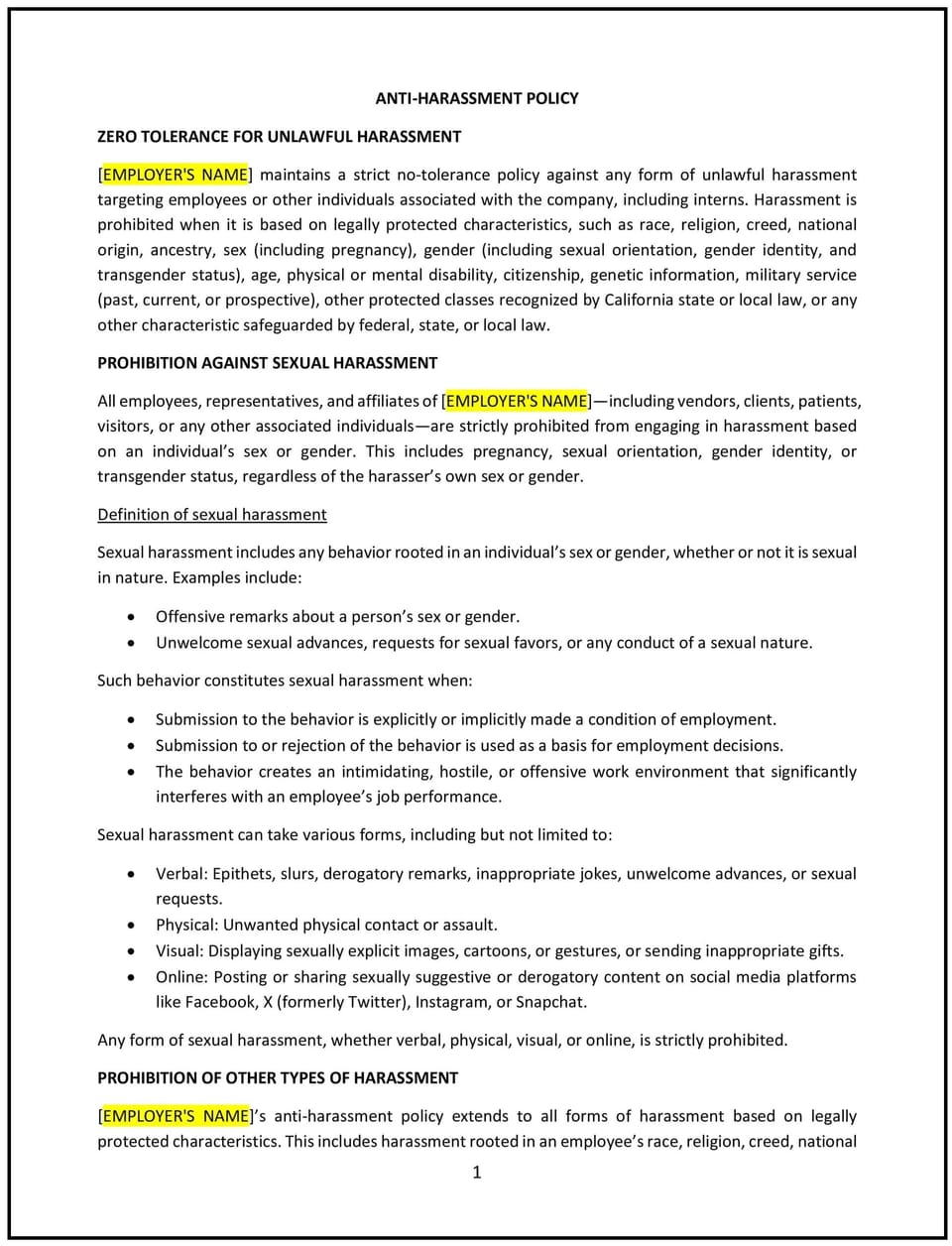Anti-harassment policy (California): Free template

Anti-harassment policy (California)
In California, an anti-harassment policy provides businesses with guidelines to prevent, address, and resolve harassment in the workplace. This policy ensures that employees, contractors, and visitors work in a respectful and inclusive environment free from discrimination, bullying, or harassment.
This policy outlines prohibited behaviors, reporting procedures, and response protocols in compliance with California’s robust anti-harassment laws, including the California Fair Employment and Housing Act (FEHA). By implementing this policy, California businesses can foster a culture of respect while minimizing legal and reputational risks.
How to use this anti-harassment policy (California)
- Define prohibited behaviors: Clearly describe forms of harassment, including verbal, physical, visual, and online behaviors, as well as harassment based on protected characteristics such as race, gender, and religion.
- Establish reporting procedures: Provide employees with multiple options for reporting harassment, including anonymous and confidential methods.
- Outline response protocols: Detail the steps the business will take to investigate reports, document findings, and take corrective actions.
- Communicate zero-tolerance: Emphasize the business’s commitment to a harassment-free workplace and the consequences of violating the policy.
- Provide training: Offer regular anti-harassment training in compliance with California law, especially for supervisors and managers.
Benefits of using this anti-harassment policy (California)
This policy offers several advantages for California businesses:
- Promotes a respectful workplace: Encourages professionalism and mutual respect, fostering a positive work culture.
- Supports compliance: Aligns with California laws, including FEHA and mandated harassment prevention training requirements.
- Reduces risks: Helps prevent legal claims, financial liabilities, and reputational harm related to harassment incidents.
- Enhances employee trust: Demonstrates the business’s commitment to protecting employees from harassment and ensuring fair treatment.
- Encourages accountability: Establishes clear guidelines and procedures for addressing harassment consistently.
Tips for using this anti-harassment policy (California)
- Address California-specific considerations: Ensure the policy complies with FEHA and local ordinances, such as training requirements for employers with five or more employees.
- Train thoroughly: Provide mandatory anti-harassment training for all employees and additional supervisory training as required by California law.
- Use clear communication: Ensure all employees understand the policy, reporting options, and the consequences of harassment.
- Document thoroughly: Maintain records of training, reports, investigations, and actions taken to demonstrate compliance and accountability.
- Review regularly: Update the policy to reflect changes in California laws, workplace dynamics, or best practices.
Q: How does this policy benefit the business?
A: This policy supports a respectful workplace, reduces legal risks, and helps the business comply with California anti-harassment laws.
Q: What behaviors are prohibited under this policy?
A: Prohibited behaviors include verbal, physical, visual, or online harassment, as well as any actions based on protected characteristics under California law.
Q: How does this policy support compliance with California laws?
A: The policy is designed to reflect best practices for managing harassment-related risks in alignment with FEHA and mandated training requirements.
Q: What steps should employees take to report harassment?
A: Employees can report harassment to their manager, HR, or through anonymous reporting channels provided by the business.
Q: How can the business ensure proper handling of harassment reports?
A: The business should follow established investigation procedures, document findings, and take prompt corrective actions as outlined in the policy.
This article contains general legal information and does not contain legal advice. Cobrief is not a law firm or a substitute for an attorney or law firm. The law is complex and changes often. For legal advice, please ask a lawyer.


